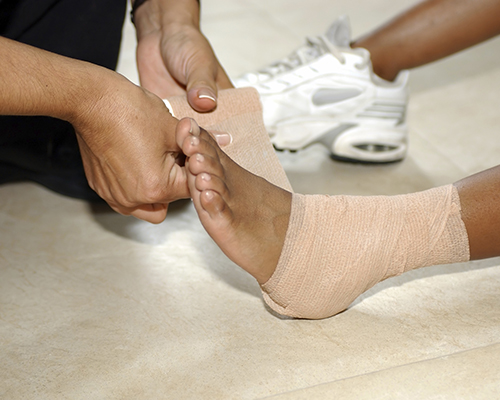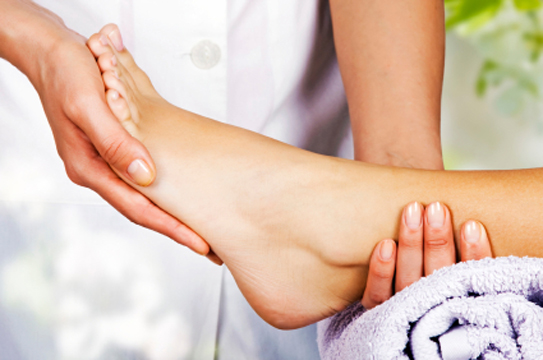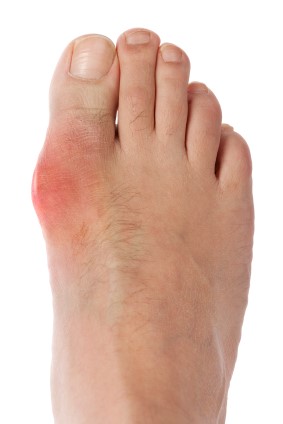Connect With Us
Items filtered by date: July 2016
Man Injures His Foot in Central Park
 A University of Miami student severely injured himself in Central Park recently on July 3rd. Connor Golden and his two friends jumped off a rock and landed on an explosive device. The device nearly blew off Golden’s leg, while his two friends were not harmed. Unfortunately for Golden, he needed surgery in order to remove his foot and may need to amputate part of his leg as well.
A University of Miami student severely injured himself in Central Park recently on July 3rd. Connor Golden and his two friends jumped off a rock and landed on an explosive device. The device nearly blew off Golden’s leg, while his two friends were not harmed. Unfortunately for Golden, he needed surgery in order to remove his foot and may need to amputate part of his leg as well.
Foot surgery is sometimes necessary to fix a foot ailment. To learn more, contact one of our podiatrists of The Podiatry Center, P.C.. Our doctors can provide the care you need to keep you pain-free and on your feet.
When Is Surgery Necessary?
Foot and ankle surgery is generally reserved for cases in which less invasive, conservative procedures have failed to help with the problem. Some of the cases in which surgery may be necessary are:
- Removing foot deformities like bone spurs and bunions
- Severe arthritis that has caused bone issues
- Cosmetic reconstruction
What Types of Surgery Are There?
The type of surgery you receive will depend on the nature of the problem you have. Some of the possible surgeries include:
- Bunionectomy for painful bunions
- Surgical fusion for realignment of bones
- Neuropathy decompression surgery to treat nerve damage
Benefits of Surgery
Although surgery is usually a last resort, it can provide more complete pain relief compared to non-surgical methods and may allow you to finally resume full activity.
Surgical techniques have also become increasingly sophisticated. Techniques like endoscopic surgery allow for smaller incisions and faster recovery times.
If you have any questions please feel free to contact one of our offices in Millburn, NJ. We offer the newest diagnostic and treatment technologies for all your foot and ankle needs.
Read more about foot surgery.
Wichita State’s Keyser Has Stress Fracture in Foot
 Wichita State freshman C.J. Keyser suffered stress injuries in his right foot. The stress injury was due to two bones in the foot rubbing together aggressively. Keyser is currently wearing crutches along with a walking boot. Keyser states that he does not need surgery to repair the injury; however he has opted to use bone stimulation as a form of rehabilitation.
Wichita State freshman C.J. Keyser suffered stress injuries in his right foot. The stress injury was due to two bones in the foot rubbing together aggressively. Keyser is currently wearing crutches along with a walking boot. Keyser states that he does not need surgery to repair the injury; however he has opted to use bone stimulation as a form of rehabilitation.
Sports related foot and ankle injuries need proper treatment before players can go back to their regular routines. If you have any concerns, contact one of our podiatrists of The Podiatry Center, P.C.. Our doctors can provide the care you need to keep your pain free and on your feet.
Sport Related Foot and Ankle Injuries
Foot and ankle injuries are a common occurrence when it comes to athletes of any sport. While many athletes dismiss the initial aches and pains, the truth is that ignoring potential foot and ankle injuries can lead to serious problems. As athletes continue to place pressure and strain the area further, a mild injury can turn into something as serious as a rupture and may lead to a permanent disability. There are many factors that contribute to sports related foot and ankle injuries, which include failure to warm up properly, not providing support or wearing bad footwear. Common injuries and conditions athletes face, including:
- Plantar Fasciitis
- Plantar Fasciosis
- Achilles Tendinitis
- Achilles Tendon Rupture
- Ankle Sprains
Sports-related injuries are commonly treated using the RICE method. This includes rest, applying ice to the injured area, compression and elevating the ankle. More serious sprains and injuries may require surgery, which could include arthroscopic and reconstructive surgery. Rehabilitation and therapy may also be required in order to get any recovering athlete to become fully functional again. Any unusual aches and pains an athlete sustains must be evaluated by a licensed, reputable medical professional.
If you have any questions please feel free to contact our office located in Millburn, NJ. We offer the newest diagnostic tools and technology to treat your foot and ankle needs.
Read more about sports related injuries.
How to Properly Care for Ingrown Toenails
 Care for ingrown toenails often begins with good practices at home. In order to prevent ingrown toenails, you should cut your nails straight across instead of cutting them in a rounded shape. Be careful not to cut your toenails too short and to wear shoes that fit properly. Soaking the feet in warm water 3-4 times per day can also help relieve pressure in the skin surrounding the ingrown nail. Consult with your podiatrist for the best way to treat ingrown toenails.
Care for ingrown toenails often begins with good practices at home. In order to prevent ingrown toenails, you should cut your nails straight across instead of cutting them in a rounded shape. Be careful not to cut your toenails too short and to wear shoes that fit properly. Soaking the feet in warm water 3-4 times per day can also help relieve pressure in the skin surrounding the ingrown nail. Consult with your podiatrist for the best way to treat ingrown toenails.
Ingrown toenails can become painful if they are not treated properly. For more information about ingrown toenails, contact one of our podiatrists of The Podiatry Center, P.C. Our doctors will answer any of your foot- and ankle-related questions.
Ingrown Toenails
Ingrown toenails occur when a toenail grows sideways into the bed of the nail, causing pain, swelling, and possibly infection.
Causes
- Bacterial infections
- Improper nail cutting such as cutting it too short or not straight across
- Trauma to the toe, such as stubbing, which causes the nail to grow back irregularly
- Ill-fitting shoes that bunch the toes too close together
- Genetic predisposition
Prevention
Because ingrown toenails are not something found outside of shoe-wearing cultures, going barefoot as often as possible will decrease the likeliness of developing ingrown toenails. Wearing proper fitting shoes and using proper cutting techniques will also help decrease your risk of developing ingrown toenails.
Treatment
Ingrown toenails are a very treatable foot condition. In minor cases, soaking the affected area in salt or antibacterial soaps will not only help with the ingrown nail itself, but also help prevent any infections from occurring. In more severe cases, surgery is an option. In either case, speaking to your podiatrist about this condition will help you get a better understanding of specific treatment options that are right for you.
If you have any questions please contact our offices located in Millburn, NJ. We offer the newest diagnostic and treatment technologies for all your foot and ankle needs.
Read more about Ingrown Toenails
Living with Gout
 Gout is a painful type of arthritis that is caused by high blood levels of uric acid. It can keep people off of their feet for several days. Hard uric acid crystal deposits can cause swelling and deformity. Gout is a permanent condition; however its symptoms are not always visible. Gout must be properly managed in order to relieve the severe pain. People who have gout should make dietary modifications and take their medication regularly. Sufferers should also drink plenty of water and maintain a healthy weight to reduce the risk of future gout attacks.
Gout is a painful type of arthritis that is caused by high blood levels of uric acid. It can keep people off of their feet for several days. Hard uric acid crystal deposits can cause swelling and deformity. Gout is a permanent condition; however its symptoms are not always visible. Gout must be properly managed in order to relieve the severe pain. People who have gout should make dietary modifications and take their medication regularly. Sufferers should also drink plenty of water and maintain a healthy weight to reduce the risk of future gout attacks.
Gout is a foot condition that requires certain treatment and care. If you are seeking treatment, contact one of our podiatrists of The Podiatry Center, P.C. Our doctors will treat your foot and ankle needs.
What is Gout?
Gout is a type of arthritis caused by a buildup of uric acid in the bloodstream. It often develops in the foot, especially the big toe area, although it can manifest in other parts of the body as well. Gout can make walking and standing very painful and is especially common in diabetics and the obese.
People typically get gout because of a poor diet. Genetic predisposition is also a factor. The children of parents who have had gout frequently have a chance of developing it themselves.
Gout can easily be identified by redness and inflammation of the big toe and the surrounding areas of the foot. Other symptoms include extreme fatigue, joint pain, and running high fevers. Sometimes corticosteroid drugs can be prescribed to treat gout, but the best way to combat this disease is to get more exercise and eat a better diet.
If you have any questions, please feel free to contact our office located in Millburn, NJ. We offer the newest diagnostic and treatment technologies for all your foot care needs.
Blog Archives
- April 2025
- March 2025
- February 2025
- January 2025
- December 2024
- November 2024
- October 2024
- September 2024
- August 2024
- July 2024
- June 2024
- May 2024
- April 2024
- March 2024
- February 2024
- January 2024
- December 2023
- November 2023
- October 2023
- September 2023
- August 2023
- July 2023
- June 2023
- May 2023
- April 2023
- March 2023
- February 2023
- January 2023
- December 2022
- November 2022
- October 2022
- September 2022
- August 2022
- July 2022
- June 2022
- May 2022
- April 2022
- March 2022
- February 2022
- January 2022
- December 2021
- November 2021
- October 2021
- September 2021
- August 2021
- July 2021
- June 2021
- May 2021
- April 2021
- March 2021
- February 2021
- January 2021
- December 2020
- November 2020
- October 2020
- September 2020
- August 2020
- July 2020
- June 2020
- May 2020
- April 2020
- March 2020
- February 2020
- January 2020
- December 2019
- November 2019
- October 2019
- September 2019
- August 2019
- July 2019
- June 2019
- May 2019
- April 2019
- March 2019
- February 2019
- January 2019
- December 2018
- November 2018
- October 2018
- September 2018
- August 2018
- July 2018
- June 2018
- May 2018
- April 2018
- March 2018
- February 2018
- January 2018
- December 2017
- November 2017
- October 2017
- September 2017
- August 2017
- July 2017
- June 2017
- May 2017
- April 2017
- March 2017
- February 2017
- January 2017
- December 2016
- November 2016
- October 2016
- September 2016
- August 2016
- July 2016
- June 2016
- May 2016
- April 2016
- March 2016
- February 2016
- January 2016
- December 2015
- November 2015
- October 2015
- September 2015
- August 2015
- July 2015
- June 2015
- May 2015
- January 2014
- December 2013
- November 2013
- October 2013
- September 2013
- August 2013
- July 2013
- June 2013
- May 2013
- April 2013
- March 2013
- February 2013
- January 2013
- December 2012
- November 2012
- October 2012
- September 2012
- August 2012
- July 2012
- June 2012
